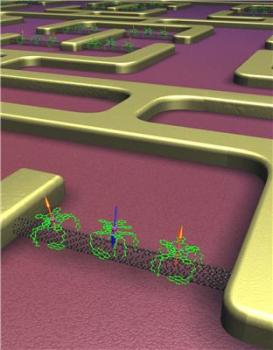A team of researchers have manufactured an electronic nano-device based on a natural mechanism. Synthetic adhesives were coated on magnetic molecules so that the molecules fitted themselves on a nanotube without any interference.
 “Self-organization” of nano-devices Magnetic molecules (green) arrange on a carbon nanotube (black) to build an electronic component
“Self-organization” of nano-devices Magnetic molecules (green) arrange on a carbon nanotube (black) to build an electronic component
In nature, green leaves grow by self-organizing themselves without any drive from subordinate mechanisms. Similarly scientists worked on the possibility of “teaching” the individual components to assemble themselves into the required product.
The nano-switch was fabricated by a group of European scientists from Centre National de la Recherche Scientifique (CNRS) in Grenoble, Institut de Physique et Chimie des Matériaux at the University of Strasbourg, and KIT’s Institute of Nanotechnology (INT) The newly fabricated component does not comprise alloys, metals or oxides but consists of soft materials such as molecules and carbon nanotubes.
The magnetic metal, Terbium, is embedded in organic material and incorporated in the equipment. Terbium is extremely sensitive to external magnetic fields. Data related to the alignment of atom along these magnetic fields is transferred efficiently to the current passing through the nanotube. The Grenoble CNRS research group led by Dr. Wolfgang Wernsdorfer was able to electrically read out the magnetism in the surroundings of the nano-component. They showed that it is possible to study electrically single magnetic molecules to open a world of opportunities in spintronics, which involves the integration of logic, memory and quantum logic.
The working of the spintronic nano-device is explained in the journal, Nature Materials for low temperatures of the order of nearly1°K. The research team is working to increase the operating temperature of the component in the near future.